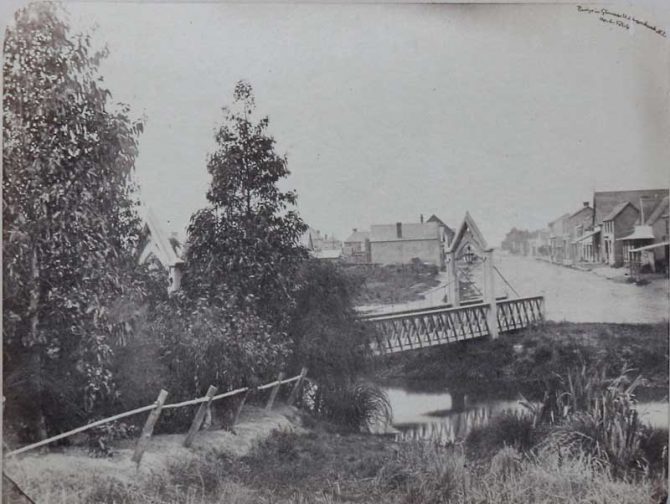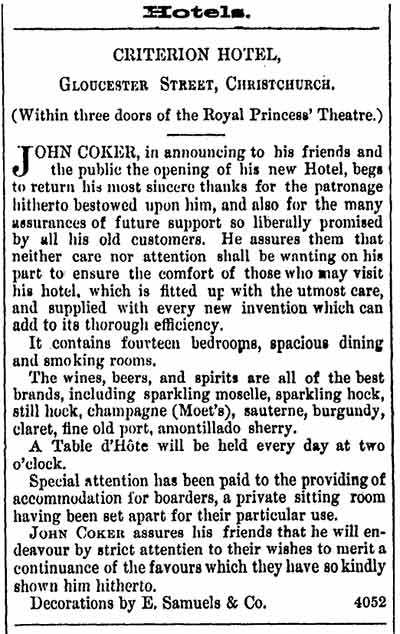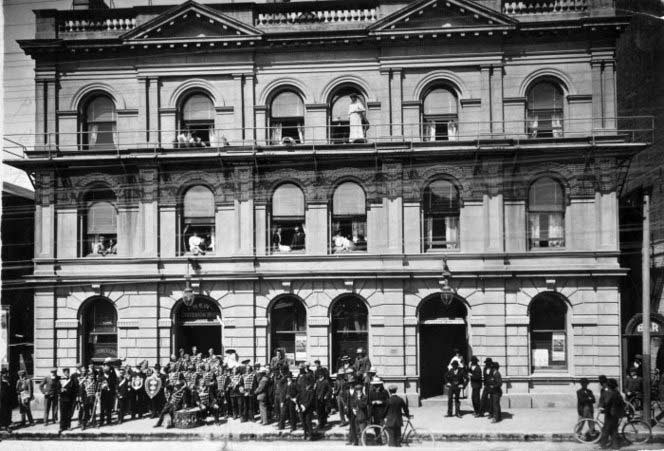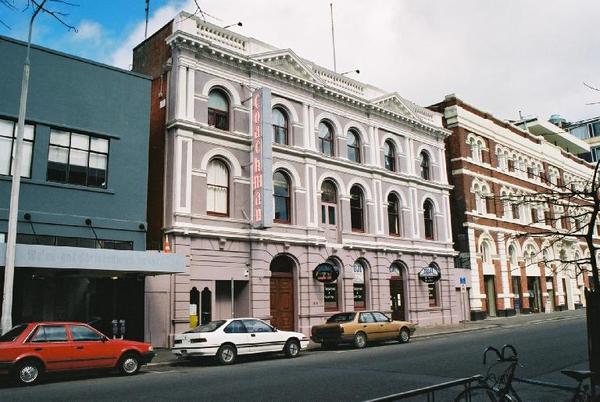The fourth in a series of posts that looks at the history of the central Christchurch sites on which your new library, Tūranga, has been built.
If you were standing in front of the spot now taken up by Tūranga's Goods Entrance on Gloucester Street on the evening of 6 November 1872 you would have been looking across at a paddock which was, at that time, playing host to a circus.
Even with all the post-demo, gravel-strewn sections in central Christchurch today, it's still strange to think of Gloucester Street as "paddocky". But indeed it was, during this part of its history.
A hotel then known as The Criterion had been built in such a paddock 9 years earlier in 1863 by someone named B. Jones. Not much is known about the first proprietor of The Criterion but more is known about their successor - by July 1864 The Criterion Hotel was under the management of local hotelier John "Jack" Coker.
Coker by this time had already declared his first (of several) bankruptcies, and had started a hotel on Cathedral Square which would later become Warner's. He cut quite the figure about town, dressing in close-fitting suits, "top boots" and carrying a hunting crop, and would be involved with several landmark hotels in Christchurch, including, naturally, Coker's Hotel on Manchester Street. Coker's tenure didn't last long. By 1866 the Criterion was in the hands of a Sgt. John Edward Darby.
The Criterion would have a run of landlords through to the turn of the century, with none lasting more that a few years (Darby fell into coma after a drunken and impromptu New Year's Eve boxing match at Coker's Music Hall and died a few days later in January 1867, having lost The Criterion several months earlier). Another landlord (and former police officer) Robert Wallace would move on from The Criterion only to die 5 years later from injuries sustained during a wrestling match, in 1888. It seems 19th century hotel-keeping appealed to a risk-taking sort of gent.
In 1892 William Burnip, an experienced hotelier, took over The Criterion renaming it, somewhat unimaginatively, "The New Criterion". By 1902 the state of the two-storey wooden building was such that a continuation of the license (due for renewal in June) would only be granted if building plans for a new premises were submitted in March of that year.
In early February of that year Burnip and his wife woke to find the hotel storeroom ablaze. No lives were lost but the hotel was gutted. The total insurance on the building and furniture was £1350, over $240,000 in today's money. Whether there was a connection is anyone's guess, but some papers in their coverage of the fire seem to have placed both sets of facts together in a pointed way that suggests the question was being asked, though not directly.
The new New Criterion rose like a phoenix from the ashes. The foundation stone for the new building was laid on 2 September 1902. The rebuilt Criterion was in stone and brick in a "Renaissance Revival" style and was built by W. H. Bowen. It was designed by Joseph Clarke Maddison, a prominent Christchurch architect who designed several hotels in the city including Warner's Hotel, The Clarendon, and further east the Lancaster Park Hotel. One of his best known designs is the Government Buildings in Cathedral Square.
Bowen had presented Burnip with a silver trowel by way of commemoration at the laying of the foundation stone but he may have wished it were a silver spoon instead. Due to the insurance company disputing the extent of the fire damage Burnip would receive less than half the insured amount and by 1904 he was no longer the sole licensee, having taken on Messrs Fox and Samson as partners. By 1906 he had passed the splendid new Criterion on to other hands. And that's when the real fun started.
A couple by the name of Green took on the New Criterion and would go on to scandalise Christchurch.
Jessie Green was the daughter of Tuapeka hotelkeeper Daniel Bannatyne and had earlier run the Douglas Hotel in Dunedin with her first husband Frank Guinness who passed away in 1895. With second husband John George Green she took over the running of the New Criterion and by the following year their conduct had become a scandal that was reported up and down the country.
The New Zealand International Exhibition of 1906-1907 took place in Hagley Park and brought a great many visitors to the city (2 million people visited the Exhibition, though the population of New Zealand was only 1 million at the time). Perhaps it was this influx of visitors, some of whom may have been more inclined to "cut loose" while away from home, that encouraged Mrs Green in her "questionable" management of the hotel bar and staff.
Rumours had been circulating for months about the "going ons" at the hotel and in September 1907 the Christchurch Licensing Committee heard evidence from a succession of barmaids, evidence that prompted the New Zealand Truth to speculate in its headline "LOW DOWN BROTHEL OR PUBLIC HOUSE". The New Zealand Herald's coverage was positively low-key by comparison preferring to distill the story to its main, eye-catching components with the simple declaration, "GIRLS AND CHAMPAGNE".
Mrs Green, it would seem, employed more barmaids than was usual (seven or eight at a time!) and encouraged them to be "shouted" champagne by the customers. This of course lead to better takings, but also in some circumstances, the female staff were getting drunk and "retiring" to their rooms where they would also receive "visitors". What went on behind closed doors nobody was indelicate enough to say outright but there was a strong suggestion of "indecency".
As always the New Zealand Truth is a treasure trove of descriptive language about the whole affair, saying of the landlady,
...it would appear that Mrs Green, wife of the licensee, John George Green, is very partial to customers who plank down the boodle and shout fizz.
And of her husband, who seemed not to have much involvement in the running of the hotel, that he must either have been blind or "a consummate ass who shouldn't have charge of a fruit-barrow".
Unsurprisingly the Licensing Committee did not renew the Greens' license and six months later they moved to Tauranga. In addition, all the barmaids (whether there was any suggestion they had participated in the "champagne shouting" or not) were fired, Blenheim native Henry Macartney became the proprietor, and the hotel was re-named The Dominion. When Macartney too moved on in 1908, the Marlborough Express was at pains to point out that "under his control the Dominion Hotel ranked as one of the best conducted in the city", such was the need to distance an upstanding publican from the Criterion scandal.
Still, a hotel is a hotel and The Dominion had its share of dramas too, such as fires and burglaries. In 1930 some alterations were made to the building by Francis Willis (architect).
In 1980 it was refurbished and reopened as The Coachman Inn, the name possibly a nod to Bruce & Coes, a passenger and parcel service, who in the 1860s had their stables and booking office next door. Later the upstairs bar would become a separate establishment operating as The Loft and specialising in Irish music (in the 1990s changing hands and becoming The Finbar), while downstairs the restaurant would be known as Excalibur's Theatre Restaurant featuring players like local theatre legend Elizabeth Moody.
In the mid-1990s the Coachman was threatened with demolition but would eventually be acquired by Christchurch City Council, due to the building's heritage values and would later become a protected building.
At the time of the earthquakes, the Coachman Inn operated as backpacker accommodation and was home, on its ground floor, to Fuji Japanese Restaurant.
Following the Boxing Day 2010 aftershock, the building was red-stickered, partly because a section of the parapet on the Britten building (105 Worcester St) had collapsed causing damage. The remaining piece of it was also a fall hazard. Part of the parapet of the Coachman had also collapsed on top of the roof of a smaller building at 146 Gloucester Street where The Press had its circulation and marketing teams. The Coachman was close to reopening when the 22 February 2011 quake damaged it beyond repair. It was demolished in July 2011.
Criterion Hotel, Gloucester Street, Christchurch
Further reading
- Our pages about Early Christchurch
- About Tūranga, Christchurch's central library
- Browse Local History resources
- Blog post about the history of the Criterion Hotel by former Town Crier, Stephen Symon
- The Coachman Inn, New Zealand Historic Places Trust










Add a comment to: Before Tūranga – The Coachman Inn